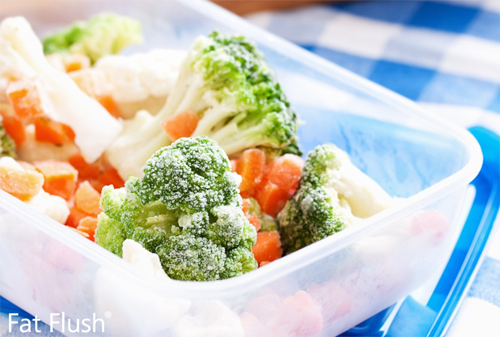
by ffadmin | May 12, 2013 | Tips & Tricks
Preparing double —or more— of a recipe and freezing the extra is an easy way to save money, time, and still have a delicious Fat Flush-friendly meal ready whenever you need it!
Here are some tips to help you freeze foods properly from start to finish:
1. Select foods that are freeze-friendly.
This tip takes some trial and error, but try to choose hearty recipes to freeze. All-inclusive meals such as soups, chili, casseroles work well. You can also cook and freeze meats like chicken and beef.
2. Cool the food before freezing.
This may sound redundant, but bare with me. Putting foods in the freezer that are still warm can alter the temperature of the freezer and impact other food you have stored there. (It may even alter the texture and flavor.) The best thing to do is place the food in a shallow container in the fridge until it’s thoroughly cooled.
For soups and stews with some fat content, skim the fat from the top between cooling and freezing. Besides cutting the ‘fat’ content— literally— this detail lengthens the time the dish can spend in the freezer as fat spoils over time, even in the freezer!
3. Efficient storage is key.
Freezer bags work perfectly as long as you remove the air from the bags before sealing. The bags allow the food to lay flat, saving you space but also exposing it to the cold air for a thorough, even freeze. Storing the food in single portions will also help keep the temperature down—the cold air can circulate freely— but it will also save you time later when you can simply thaw as many portions as you need (single helpings, 2, 3, etc).
4. Freeze it fast!
Don’t let the dish sit around the fridge for a few days before you freeze it. The fresher it is when it’s frozen, the better the quality when it’s thawed. Most dishes will keep in the freezer for 2-3 months.
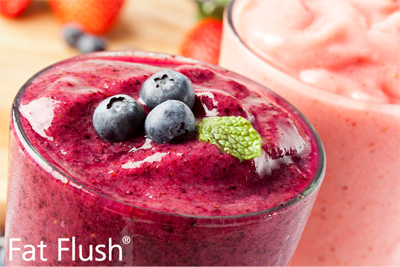
by ffadmin | May 7, 2013 | Tips & Tricks
Smoothies are a convenient, delicious, one-stop-shop for a daily helping of essential vitamins and nutrients. (Not to mention all the time and money you save!) But it’s kinda like making a sandwich— there’s a strategy to making the perfect smoothie! Here are some of our most important tips:
1. Order counts!
First measure your water, then add the ice, protein powder and fruit. Blend those until smooth, then add any extras— ie mint, cinnamon, chia seeds, etc. This is to make sure the base ingredients are full incorporated and will give you a smoother texture.
2. Use the hatch!
Most blenders come with a nifty little hatch built into the lid— this is the removable piece in the center of the lid. It’s designed so you can add things while the blender is on, without making a mess. If you’re adding flaxseed oil, this is the spot! After the base ingredients and extras are pretty well incorporated, lift the hatch and stream the oil into the smoothie while the blender is still running. This will fully incorporate the oil into the smoothie which makes it nearly undetectable, and will also give your smoothie a thicker, more rich texture.
3. Fruit: Fresh or Frozen?
This is definitely your call! Most Fat Flush veterans like to use frozen fruit because you can buy it in bulk and have it on-hand and ready no matter the season. Frozen fruit can also make ice unnecessary because the fruit pieces are like little ice cubes themselves.
4. Save some for later!
Some people like to use smoothies as a time-saver— and we agree. They’re mighty convenient! If you know you won’t have a chance to cook later, or can’t make another smoothie, it is possible to make 2 smoothies in a batch, freezing one for later. Depending on the efficiency of your freezer, it can come out later as more of an ice cream treat than a protein smoothie! Jackpot! If it’s too frozen when you take it out, just let it sit at room temperature for a few minutes until it’s thawed to just the right texture. (You may want to stir it again just to be sure it’s all mixed up.)
These tips are based purely on our experiences and feedback from other Fat Flush smoothie-makers. If something doesn’t work for you, feel free to experiment and find the way to make your perfect smoothie!
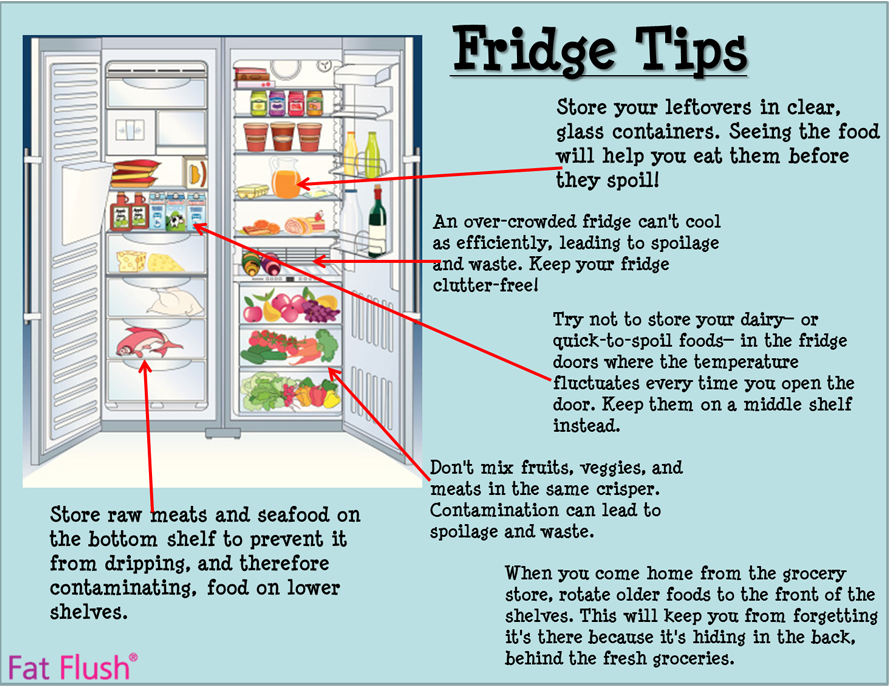
by ffadmin | May 5, 2013 | Tips & Tricks
Your refrigerator holds very important little morsels of your healthy diet.
There is a strategy to keeping everything organized, and fresh, which helps you eat only the best foods— and can save you some money, too!
Try some of these tips:
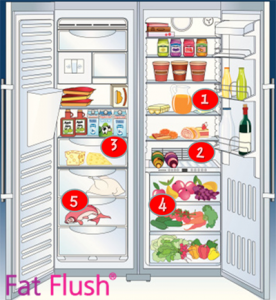
1. Store your leftovers in clear, glass containers. Seeing the food will help you eat them before they spoil!
2. An over-crowded fridge can’t cool as efficiently, leading to spoilage and waste. Keep your fridge clutter-free!
3. Try not to store your dairy— or quick-to-spoil foods— in the fridge doors where the temperature fluctuates every time you open the door. Keep them on a middle shelf instead.
4. Don’t mix fruits, veggies, and meats in the same crisper. Contamination can lead to spoilage and waste.
5. When you come home from the grocery store, rotate older foods to the front of the shelves. This will keep you from forgetting it’s there because it’s hiding in the back, behind the fresh groceries.
6. Store raw meats and seafood on the bottom shelf to prevent it from dripping, and therefore contaminating, food on lower shelves.

by ffadmin | Apr 9, 2013 | Tips & Tricks
More than just a flavor boost that warms your taste buds, this spice carries multiple health benefits! Here are some of our favorites:
1. Just 1/2 teaspoon of cinnamon a day can lower your LDL (“bad”) cholesterol.
2. It helps keep blood sugar levels in check and increases the amount of insulin your body produces.
3. The spice has antifungal properties, helping your body fight off candida overgrowth.
4. Cinnamon keeps blood platelets from clotting.
5. Honey and cinnamon have been known to relieve arthritis pain.
6. It’s an effective natural remedy for headaches and migraines.
7. Contains antibacterial properties that prevent food spoilage.
8. Offers fiber, calcium, iron, and manganese.
9. Studies show it may reduce proliferation of cancer cells, encouraging hope for prevention and healing.
10. A natural chemical called cinnamaldehyde has shown to improve balance of the progesterone and testosterone hormones.
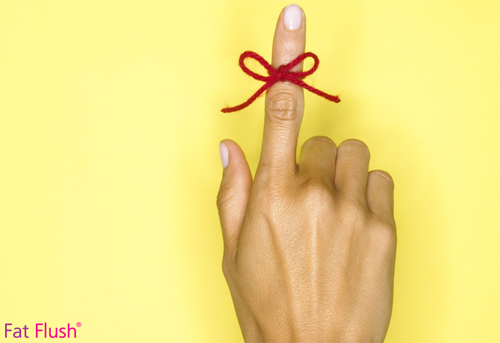
by ffadmin | Mar 6, 2013 | Tips & Tricks
Straight from the members of the Fat Flush Forum, here are some basics you should keep in mind when starting up on the Fat Flush Plan.
1. We love ground flaxseed not flaxmeal. Keep in mind, flaxmeal is ground too finely but milled or ground flaxseeds are barely broken up. Chewing whole flaxseeds won’t do the trick because they are pretty tough and will simply pass through your system intact.
2. Cran-water is not just any ol’ cranberry juice. It needs to be made with unsweetened cranberry juice or unsweetened cranberry juice concentrate. No added sugars! If it tastes too tart, adding sweetener is not recommended. After all, you avoided additive sweeteners when you bought the juice, right? Try diluting it with a bit more water.
3. A bout of irregularity…is regular. Changing your diet drastically can shock your system and result in constipation or diarrhea. For constipation, we recommend more magnesium. Also be sure to drink more water and eat more veggies! These are things that will naturally get things “moving”. For diarrhea, be sure you are using a probiotic.
4. Feeling hungry? Eat more! (Approved veggies, that is.) The veggies on the approved list are unlimited, so if you’re feeling hungry the only thing between you and a satisfied tummy is the space between you and a handful of cherry tomatoes (or whatever your favorite vegetable is). Eating often keeps cravings away and keeps your blood sugar balanced.
5. Recipes are mere suggestions. You don’t have to follow each recipe to the letter— if you don’t like onion, leave out the onion. Sticking with the general eating protocols and “legal” foods is what’s important. Get creative!
6. Don’t see it on the “approved” list? It isn’t approved. Each food was included, or left off, because of it’s impact on your body and how it’s metabolized. That’s why the food list is so strict in phase 1 and Smoothie Shakedown— when you take out the trash, you bag it all up and take it all out, you don’t leave little pieces laying around here and there. Phases 2 and 3 start to add in more foods and have more allowances, but until you get there…stick with the specifically approved foods!
Still have some burning questions? Visit the forum>>






